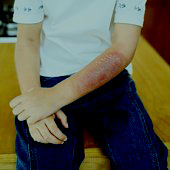Health > First Aid >Burns
Burns
To distinguish a minor burn from a serious burn, the first step is to determine the degree and the extent of damage to body tissues. The three classifications of first-degree burn, second-degree burn and third-degree burn will help you determine emergency care:
First-degree burn

The least serious burns are those in which only the outer layer of skin (epidermis) is burned. The skin is usually red, with swelling and pain sometimes present. The outer layer of skin hasn't been burned through. Treat a first-degree burn as a minor burn unless it involves substantial portions of the hands, feet, face, groin or buttocks, or a major joint.
Second-degree burn
When the first layer of skin has been burned through and the second layer of skin (dermis) also is burned, the injury is termed a second-degree burn. Blisters develop and the skin takes on an intensely reddened, splotchy appearance. Second-degree burns produce severe pain and swelling.
Home Remedies
*After a burn, the very first thing that you should do is to reduce the temperature of the burnt area. Put lots of chilled water or dip that body part into chilled water for 15 to 30 minutes. Don't put ice on the burn.
*Apply honey to the wound once you have washed the wound properly. It will prevent infection and will heal the wound.
*Aloe Vera is good for treating burns. Cut some fresh aloe Vera leaves and put it on the burnt area.
*Take an over-the-counter pain reliever. These include aspirin, ibuprofen (Advil, Motrin, others), naproxen (Aleve) or acetaminophen (Tylenol, others). Never give aspirin to children or teenagers.
Third-degree burn
The most serious burns are painless and involve all layers of the skin. Fat, muscle and even bone may be affected. Areas may be charred black or appear dry and white. Difficulty inhaling and exhaling, carbon monoxide poisoning or other toxic effects may occur if smoke inhalation accompanies the burn.
For major burns, dial 911 or call for emergency medical assistance. Until an emergency unit arrives, follow these steps:
1. Don't remove burnt clothing. However, do make sure the victim is no longer in contact with smoldering materials or exposed to smoke or heat.
2.Don't immerse severe large burns in cold water. Doing so could cause shock.
3.Check for signs of circulation (breathing, coughing or movement). If there is no breathing or other sign of circulation, begin cardiopulmonary resuscitation (CPR).
4. Cover the area of the burn. Use a cool, moist, sterile bandage; clean, moist cloth; or moist towels.
|

